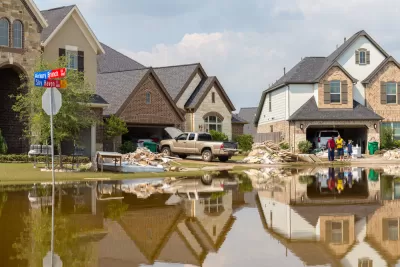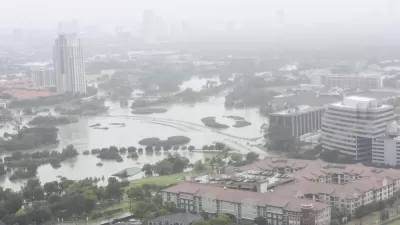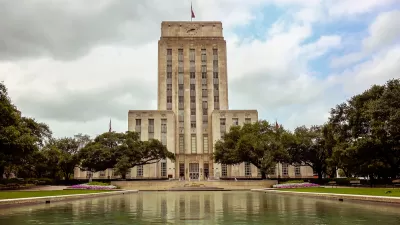Despite the devastation wrought by Hurricane Harvey, builders and buyers alike are sustaining a market for new construction on land likely to get flooded again.

Some Houston developers and homebuyers seem to "see opportunity in devastation," according to reporting by Mike Morris and Matt Dempsey. "One in 5 new homes permitted in Houston in the year after Hurricane Harvey is in a flood plain — some on prairie developed for the first time after the storm — even as new rainfall data showed existing flood maps understate the risk posed by strengthening storms."
Many of those permits went to owners razing and elevating flooded homes, but plenty of new construction is also occurring, including "clumps of townhomes, packing more families into the flood plain."
In April, Houston's city council tightened rules on flood plain construction, extending "regulations from the 100-year flood plain to the broader 500-year flood plain and [requiring] new homes built in those areas to sit higher off the ground." But Mayor Sylvester Turner doesn't see a future in abandoning those areas outright. "Houston cannot and should not abandon a third of the city to avoid flooding any more than San Francisco should abandon numerous established neighborhoods that could be affected by earthquakes," he said.
Other civic leaders disagree, and have called for the eventual depopulation of the flood plain, "perhaps by pouring billions of dollars into buying out tens of thousands of at-risk homes." Meanwhile, some developers think the post-Harvey rebuilding spree will have a limited shelf life, arguing that heightened regulation and the cost of elevated homes will eventually deter builders from choosing flood plain sites.
FULL STORY: Even after Harvey, Houston keeps adding new homes in flood plains

Trump Administration Could Effectively End Housing Voucher Program
Federal officials are eyeing major cuts to the Section 8 program that helps millions of low-income households pay rent.

Planetizen Federal Action Tracker
A weekly monitor of how Trump’s orders and actions are impacting planners and planning in America.

Ken Jennings Launches Transit Web Series
The Jeopardy champ wants you to ride public transit.

California Invests Additional $5M in Electric School Buses
The state wants to electrify all of its school bus fleets by 2035.

Austin Launches $2M Homelessness Prevention Fund
A new grant program from the city’s Homeless Strategy Office will fund rental assistance and supportive services.

Alabama School Forestry Initiative Brings Trees to Schoolyards
Trees can improve physical and mental health for students and commnity members.
Urban Design for Planners 1: Software Tools
This six-course series explores essential urban design concepts using open source software and equips planners with the tools they need to participate fully in the urban design process.
Planning for Universal Design
Learn the tools for implementing Universal Design in planning regulations.
Ada County Highway District
Clanton & Associates, Inc.
Jessamine County Fiscal Court
Institute for Housing and Urban Development Studies (IHS)
City of Grandview
Harvard GSD Executive Education
Toledo-Lucas County Plan Commissions
Salt Lake City
NYU Wagner Graduate School of Public Service





























